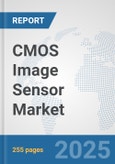The report on CMOS image sensor market is a comprehensive study and presentation of drivers, restraints, opportunities, demand factors, market size, forecasts, and trends in the global CMOS image sensor market over the period of 2022-2032. Moreover, the report is a collective presentation of primary and secondary research findings.
Porter's five forces model in the report provides insights into the competitive rivalry, supplier and buyer positions in the market and opportunities for the new entrants in the global CMOS image sensor market over the period of 2022-2032. Furthermore, the growth matrix given in the report brings an insight into the investment areas that existing or new market players can consider.
Report Findings
1) Drivers
- CMOS image sensors are becoming more prevalent in the consumer electronics industry is driving market growth.
- Rising demand for CMOS image sensors, as the rising number of IoT devices is expected to propel market growth.
2) Restraints
- The costly nature of 3D packaging is expected to hamper market growth.
3) Opportunities
- Rapid growth of 3D imaging technology due to technological advancement will create market growth opportunities.
Research Methodology
A) Primary Research
The primary research involves extensive interviews and analysis of the opinions provided by the primary respondents. The primary research starts with identifying and approaching the primary respondents, the primary respondents are approached include1. Key Opinion Leaders
2. Internal and External subject matter experts
3. Professionals and participants from the industry
The primary research respondents typically include
1. Executives working with leading companies in the market under review2. Product/brand/marketing managers
3. CXO level executives
4. Regional/zonal/ country managers
5. Vice President level executives.
B) Secondary Research
Secondary research involves extensive exploring through the secondary sources of information available in both the public domain and paid sources. Each research study is based on over 500 hours of secondary research accompanied by primary research. The information obtained through the secondary sources is validated through the crosscheck on various data sources.The secondary sources of the data typically include
1. Company reports and publications2. Government/institutional publications
3. Trade and associations journals
4. Databases such as WTO, OECD, World Bank, and among others.
5. Websites and publications by research agencies
Segment Covered
The global CMOS image sensor market is segmented on the basis of spectrum, image processing technology, resolution, and end-use.The Global CMOS Image Sensor Market by Spectrum
- Visible
- Non-visible
The Global CMOS Image Sensor Market by Image Processing Technology
- 2D
- 3D
The Global CMOS Image Sensor Market by Resolution
- Up to 5 MP
- 5 MP to 12 MP
- 12 MP to 16 MP
- Above 16 MP
The Global CMOS Image Sensor Market by End-use
- Aerospace & Defense
- Automotive
- Consumer Electronics
- Healthcare & Lifesciences
- Industrial
- Security & Surveillance
- Others
Company Profiles
The companies covered in the report include
- Panasonic Corporation
- Canon Inc.
- OmniVision Technologies Inc.
- Sony Corporation
- ON Semiconductor Corporation
- ams OSRAM AG
- GalaxyCore Shanghai Limited Corporation
- Hamamatsu Photonics K.K.
- Himax Technologies, Inc.
- PixArt Imaging Inc.
What does this report deliver?
1. Comprehensive analysis of the global as well as regional markets of the CMOS image sensor market.2. Complete coverage of all the segments in the CMOS image sensor market to analyze the trends, developments in the global market and forecast of market size up to 2032.
3. Comprehensive analysis of the companies operating in the global CMOS image sensor market. The company profile includes analysis of product portfolio, revenue, SWOT analysis and latest developments of the company.
4. Growth Matrix presents an analysis of the product segments and geographies that market players should focus to invest, consolidate, expand and/or diversify.








